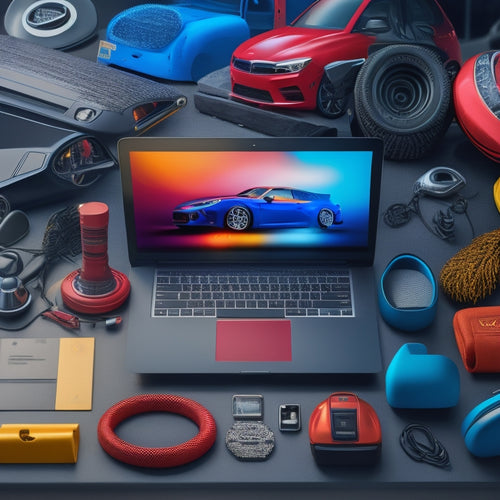
What Size Solar Panel System Fits My Roof?
Share
You'll need to evaluate your energy needs and roof space to determine the ideal solar panel system size. Conduct an energy audit to identify areas of inefficiency and improvement opportunities. Inspect your roof to confirm its structural integrity can support solar panels. Calculate the available space, considering obstructions and shading, to determine the required square footage. Factor in your energy usage patterns, sunlight exposure, and panel efficiency to determine the right system size for your unique needs. As you explore your options, you'll uncover more nuances to optimize your system's performance and energy yield.
Key Takeaways
• Determine your energy needs through an energy audit and roof inspection to identify areas of inefficiency and opportunities for improvement.
• Assess your roof's available space, considering size, layout, and obstructions, to calculate the total square footage required for the solar panel system.
• System size requirements are based on energy needs, available roof space, energy usage patterns, sunlight exposure, and panel efficiency.
• Panel size impacts system performance and aesthetics, and the ideal size is determined by considering system efficiency and regional climate conditions.
• A professional solar installer will tailor the system design to your unique needs, ensuring an optimized system size and maximum energy production.
Assessing Your Roof's Energy Needs
To determine the size of your solar panel system, you'll need to calculate your roof's energy needs by considering your energy usage patterns and the amount of energy you want to offset with solar power. This is where an energy audit comes in - a thorough examination of your energy consumption habits.
It's like taking a snapshot of your energy usage, identifying areas of inefficiency, and pinpointing opportunities for improvement. A roof inspection is also important, as it helps assess the structural integrity of your roof and determines if it's suitable for solar panels.
Think of it as a health check for your roof and energy usage. By conducting an energy audit and roof inspection, you'll get a clear picture of your energy needs and identify potential obstacles. This information will help you determine the ideal size of your solar panel system, ensuring you generate enough clean energy to meet your needs.
Calculating Space for Solar Panels
You've got a clear picture of your energy needs, now it's time to calculate the space required for your solar panel system to meet those needs. This is where things get a bit more technical, but don't worry, we'll break it down step by step.
To determine the space needed, you'll need to take into account the size and layout of your roof, considering any obstructions like vents, skylights, or chimneys. These roof obstructions will reduce the available space for your solar panels, so be sure to factor them in.
Next, you'll need to conduct a shading analysis to identify any areas of your roof that receive partial or full shade throughout the day. This will help you identify the best placement of your solar panels to maximize energy production.
By accounting for these factors, you'll be able to calculate the total square footage required for your solar panel system.
Stay tuned, we're getting closer to determining the ideal system size for your roof!
Determining System Size Requirements
With your energy needs and available roof space calculated, it's time to assess the system size requirements that will meet your energy demands. This is where things can get a bit complex, but stick with us – it's worth it! You're about to find out exactly how big your solar panel system needs to be to cover your energy usage.
To determine the ideal system size, you'll need to take into account factors like your energy usage patterns, the amount of sunlight your roof receives, and the efficiency of the solar panels themselves. This is where an energy audit comes in handy. A thorough energy audit will identify areas of energy inefficiency in your home, helping you pinpoint opportunities to reduce your energy consumption and optimize your solar panel system.
System complexity also plays a role in determining system size. For instance, if you have multiple electrical panels or a complex roof layout, your system may require more components, increasing its overall size.
Don't worry, though – a professional solar installer will take all these factors into account to design a system that's tailored to your unique needs.
Panel Size and Roof Orientation
How will the size and orientation of your solar panels impact the overall system's performance, and what considerations must you make to guarantee maximum energy harvesting?
When it comes to panel size, it's not just about fitting as many panels on your roof as possible. You need to think about the roof's aesthetics and the system's performance. A larger panel may not always be the best option, especially if it compromises the system's efficiency.
| Panel Angle | Energy Harvesting |
|---|---|
| 30° | Ideal for most locations, capturing 90% of available energy |
| 45° | Suitable for areas with heavy shading or snowfall |
| 15° | Best for regions with intense sunlight, like deserts |
Panel angles also play an essential role in energy harvesting. A 30° angle is best for most locations, but you may need to adjust this based on your region's climate and shading conditions. By taking these factors into account, you can ensure your solar panel system operates at maximum efficiency, giving you the most value for your money.
Optimizing System Performance Metrics
To maximize your solar panel system's energy production, it's crucial that you monitor and optimize key performance metrics, including energy yield, capacity factor, and performance ratio. These metrics give you a clear picture of your system's efficiency and help you identify areas for improvement.
By keeping a close eye on these numbers, you can make data-driven decisions to boost your system's performance and enjoy greater efficiency gains.
Monitoring tools are your best friend when it comes to optimizing your system's performance. With real-time data and analytics, you can pinpoint issues, detect potential problems, and make adjustments on the fly.
This proactive approach guarantees your system runs at peak performance, maximizing your energy yield and reducing downtime.
Frequently Asked Questions
Can I Install Solar Panels on a Metal or Tile Roof?
You can definitely install solar panels on a metal or tile roof, but it's important to verify that the roof material can support the added weight and consider specialized mounting systems for a secure fit.
How Long Does It Take to Install a Solar Panel System?
You're wondering how long it takes to install a solar panel system? Typically, it takes 2-5 days, depending on the complexity of the installation, electrical upgrades needed, and the installation team's experience, but don't worry, it's worth the wait!
Are Solar Panels Resistant to Hail and Extreme Weather?
You're right to wonder if solar panels can withstand Mother Nature's tantrums! Rest assured, modern solar panels are built to endure extreme weather conditions, boasting impressive weather durability and storm resistance, so you can relax during those intense hail storms.
Can I Add More Solar Panels to My Existing System?
You're wondering if you can add more solar panels to your existing system? Absolutely! A system upgrade can give you an energy boost, and it's a great way to increase your energy independence, all while saving more green - and we're not just talking about the environment!
Do Solar Panels Void My Roof's Warranty?
You're wondering if solar panels will void your roof's warranty? Fear not! A thorough roof inspection guarantees a smooth install, and most manufacturers honor warranty coverage, so you're good to go, with a little due diligence, of course!
Related Posts
-

5 Essential Tips for Buying EV Charging Systems Online
When purchasing an EV charging system online, you'll want to make sure you're making an informed decision. First, det...
-

Top 10 Tips for Buying Car Accessories Online
When purchasing car accessories online, you should take proactive steps to avoid low-quality or incompatible products...
-

Reduce Solar Panel Cost for Your Small Home
By evaluating your energy needs, choosing the right installer, and selecting cost-effective solar panel options, you ...


